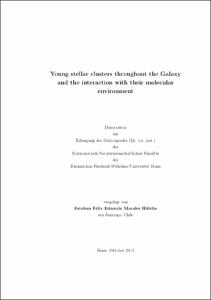Young stellar clusters throughout the Galaxy and the interaction with their molecular environment

Young stellar clusters throughout the Galaxy and the interaction with their molecular environment

| dc.contributor.advisor | Menten, Karl M. | |
| dc.contributor.author | Morales Häfelin, Esteban Félix Eduardo | |
| dc.date.accessioned | 2020-04-19T19:32:54Z | |
| dc.date.available | 2020-04-19T19:32:54Z | |
| dc.date.issued | 28.02.2014 | |
| dc.identifier.uri | https://hdl.handle.net/20.500.11811/6041 | |
| dc.description.abstract | Stars are born within dense clumps of giant molecular clouds, constituting young stellar agglomerates known as embedded clusters. Once the parental gas is expelled through stellar feedback, they evolve into bound open clusters only under special conditions. In this thesis, we study observationally all embedded clusters (ECs) and open clusters (OCs) known so far in the inner Galaxy, investigating particularly their interaction with the surrounding molecular environment. We first compiled a merged list of 3904 clusters from optical and infrared clusters catalogs in the literature, including 71 new embedded clusters discovered by us in the GLIMPSE mid-infrared data after applying a red-color criterion. From this list, 695 clusters are within the Galactic range |l| < 60 degrees and |b| < 1.5 degrees covered by the ATLASGAL survey, which was used to search for correlations with submm dust continuum emission tracing dense molecular gas. Based on the morphology of this emission, we defined an evolutionary sequence of five morphological types: deeply embedded cluster (EC1), partially embedded cluster (EC2), emerging open cluster (OC0), open cluster still associated with a submm clump in the vicinity (OC1), and open cluster without correlation with ATLASGAL (OC2). We found that this sequence correlates well with other observational indicators of evolution, such as UV-excited PAH emission and H II regions tracing stellar feedback in the first four evolutionary stages, and infrared dark clouds probing a very early phase within the EC1 type. We also found that an OC defined observationally in this way (clusters with types OC0, OC1 and OC2 and confirmed as real clusters) is equivalent to the physical concept of open cluster (a bound exposed cluster) for ages in excess of ~16 Myr; some observed OCs younger than this limit can be actually unbound associations. We found that our OC and EC samples are roughly complete up to ~1 kpc and ~1.8 kpc from the Sun, respectively, after which the completeness decays exponentially. Using available age estimates for a few ECs, we derived an upper limit of 3 Myr for the duration of the embedded phase. Combined with the OC age distribution within 3 kpc from the Sun, we computed formation rates of 0.54, 1.18, and 6.50 Myr^-1 kpc^-2 for bound open clusters, all observed young exposed clusters, and embedded clusters, respectively, implying an EC dissolution fraction of 88% +- 8%. We carried out follow-up 13CO(2-1) and C18O(2-1) mapping observations towards a subsample of 14 clusters showing evidence of ongoing stellar feedback in our previous analysis, and we indeed found kinematic signatures of enhanced turbulence and expanding motions. A more detailed study towards the IR bubble G10.31-0.14, including a comparison with simple geometrical models of the velocity field, reveals that this source is more likely an expanding molecular ring inclined with respect to the plane of the sky, rather than a 3D shell seen in projection. | en |
| dc.language.iso | eng | |
| dc.rights | In Copyright | |
| dc.rights.uri | http://rightsstatements.org/vocab/InC/1.0/ | |
| dc.subject.ddc | 520 Astronomie, Kartografie | |
| dc.title | Young stellar clusters throughout the Galaxy and the interaction with their molecular environment | |
| dc.type | Dissertation oder Habilitation | |
| dc.publisher.name | Universitäts- und Landesbibliothek Bonn | |
| dc.publisher.location | Bonn | |
| dc.rights.accessRights | openAccess | |
| dc.identifier.urn | https://nbn-resolving.org/urn:nbn:de:hbz:5n-35186 | |
| ulbbn.pubtype | Erstveröffentlichung | |
| ulbbnediss.affiliation.name | Rheinische Friedrich-Wilhelms-Universität Bonn | |
| ulbbnediss.affiliation.location | Bonn | |
| ulbbnediss.thesis.level | Dissertation | |
| ulbbnediss.dissID | 3518 | |
| ulbbnediss.date.accepted | 12.03.2013 | |
| ulbbnediss.fakultaet | Mathematisch-Naturwissenschaftliche Fakultät | |
| dc.contributor.coReferee | Kroupa, Pavel |
Files in this item
This item appears in the following Collection(s)
-
E-Dissertationen (4465)




